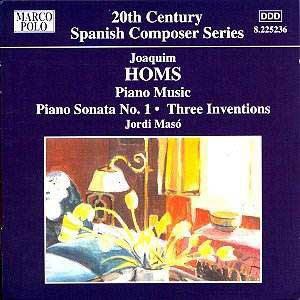Joaquim Homs was the late Roberto Gerhard’s only pupil.
(He actually wrote a book about Gerhard some ten or fifteen years ago.)
Unlike his teacher, Homs remained in Spain working as an engineer while
devoting much of his time to music, as a composer and as a performing
cellist. His music generally eschews any attempt at narrow nationalism
or at the then prevailing Neo-classicism. Quite early in his composing
life, he was attracted to atonality and even serialism although his
music rarely adheres strictly to serial principles. Some of his earlier
pieces such as his Variations on a Popular Catalan Tune
(1943) and Carousel Waltz (1934) recorded here may still
be said to belong to some more traditional trends, but the impressive
Piano Sonata No.1 of 1945 is a compact, tightly argued
piece laid-out in a clearly atonal, chromatic idiom, possibly nearer
to Berg than to Schönberg, in its emotionally charged and tensely
expressive content. It is by far the most substantial piece in this
selection.
Between Two Lines (1948) a suite of
short, simple character sketches, still slightly harks back to some
sort of Neo-classical simplicity: tuneful, colourful and full of contrasts.
A delightful work and a good introduction to Homs’ music making. (Incidentally,
the back cover dates this piece as from 1958, but the date of 1948 mentioned
in the notes is much more likely.)
Indeed the Three Inventions on One Chord
from 1958 clearly show how far Homs’ style has evolved over the years.
The music of these studies is more stringent, forceful, at times more
violent and displays a greater economy of means, while exploiting the
piano’s expressive range in a more searching way.
On the other hand, the more recent pieces with which
this selection ends, are all – in one way or another – imbued with nostalgic
thoughts. The Three Invocations (actually In memoriam
Turina and Diptych for Frederic Mompou), written
between 1982 and 1987, as well as the short tribute to Arthur Rubinstein
probably written either in 1982 or 1983, are generally simple, affectionate
tributes to some of his friends and colleagues.
The set titled Remembrances, composed
between 1984 and 1995, also pays homage to friends and family members.
The longest piece of the set is inscribed In memoriam P.F.A.,
i.e. possibly Pietat Fonseca, the composer’s wife. This long sorrowful
elegy has the pianist briefly drumming on the piano, thus enhancing
the ominous, funeral mood of the piece. The other pieces of the set
are all mostly elegiac in mood, full of restrained emotion but deeply
moving.
Jordi Masó, who has already recorded a first
volume of Homs’ piano music (MARCO POLO 8.225099 AmazonUK
AmazonUS)
and who has included Homs’ Second Piano Sonata in his recording of Gerhard’s
piano works (MARCO POLO 8.223867 AmazonUK
AmazonUS),
obviously has a deep understanding of and a real sympathy for Homs’
music which he plays with assurance and conviction.
Hubert Culot


![]() See
what else is on offer
See
what else is on offer 